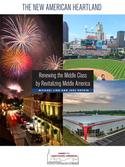The Budapest area has lost population overall since 1980, having fallen from 3.03 million to 2.99 million in 2016, according to Hungarian Central Statistical Office data as reported by citypopulation.de (Graphic 1). This 1.3 percent loss is smaller than the national population loss over the same period of 8.2 percent. Moreover, during the last five years, the Budapest area is estimated to have gained 1.7 percent, even as Hungary lost 1.1 percent. read more »
Demographics
America's Heartland is Critical to Our Future
The results of the 2016 presidential election have been ascribed -- by the winner’s critics -- to racism, hysteria, stupidity, or nostalgia. But what the results most reflected was a looming economic divide. Essentially, Donald Trump won in the parts of the country that grow most of the food, drill for oil and gas, and produce palpable things. The places that went for Hillary Clinton are where intangibles such as media, software, and financial transactions drive the economy. read more »
- Login to post comments
Move Over, San Francisco: Dallas Tops Our List Of The Best Cities For Jobs 2017
Dallas is called the Big D for a reason. Bigger, better, best: that’s the Dallas mindset. From the gigantic Cowboys stadium in Arlington to the burgeoning northern suburbs to the posh arts district downtown, Dallasites are reinventing their metropolis almost daily. The proposed urban park along the Trinity River, my Dallas friends remind me, will be 11 times bigger than New York’s Central Park. read more »
- Login to post comments
The New American Heartland: Renewing the Middle Class by Revitalizing the Heartland
This is the introduction to a new report written by Joel Kotkin and Michael Lind with a team of contributors. Download the full report (pdf) here.
The greatest test America faces is whether it can foster the kind of growth that benefits and expands the middle class. To do so, the United States will need to meet three challenges: recover from the Great Recession, rebalance the American and international economies, and gain access to the global middle class for the future of American goods and services. read more »
- Login to post comments
The globalization debate is just beginning
The decisive victory of Emmanuel Macron for president of France over Marine Le Pen is being widely hailed as a victory of good over evil, and an affirmation of open migration flows and globalization. Certainly, the defeat of the odious National Front should be considered good news, but the global conflict over trade and immigration has barely begun. read more »
- Login to post comments
California's War on the Emerging Generation
It should be the obligation of older citizens to try to improve the prospects for their successors. But, here in California, as seen in a new report issued by the Chapman Center for Demographics and Policy, we seem to have adopted an agenda designed to make things tougher for them. read more »
- Login to post comments
The Evolving Urban Form: Warsaw
Like other major cities in the high income world, Warsaw has seen central area population losses, with all of the population growth taking place outside the urban core, principally in the suburbs and exurbs (Graphic 1). The city's districts were reconfigured so that direct comparisons cannot be made before the 2002 census. read more »
- Login to post comments
The news media are losing their search for truth
To someone who has spent most of his career in the news business, it’s distressing to confront the current state of the media. Rather than a source of information and varied opinion, the media increasingly act not so such as disseminators of information but as a privileged and separate caste, determined to shape opinion to a certain set of conclusions. read more »
Father of the Bernie Sanders Presidency
President Trump’s elite-managed populism opens a path for a more genuine version. read more »
California Squashes Its Young
In this era of anti-Trump resistance, many progressives see California as a model of enlightenment. The Golden State’s post-2010 recovery has won plaudits in the progressive press from the New York Times’s Paul Krugman, among others. Yet if one looks at the effects of the state’s policies on key Democratic constituencies— millennials, minorities, and the poor—the picture is dismal. A recent United Way study found that close to one-third of state residents can barely pay their bills, largely due to housing costs. When adjusted for these costs, California leads all states—even historically poor Mississippi—in the percentage of its people living in poverty. read more »
- Login to post comments




















